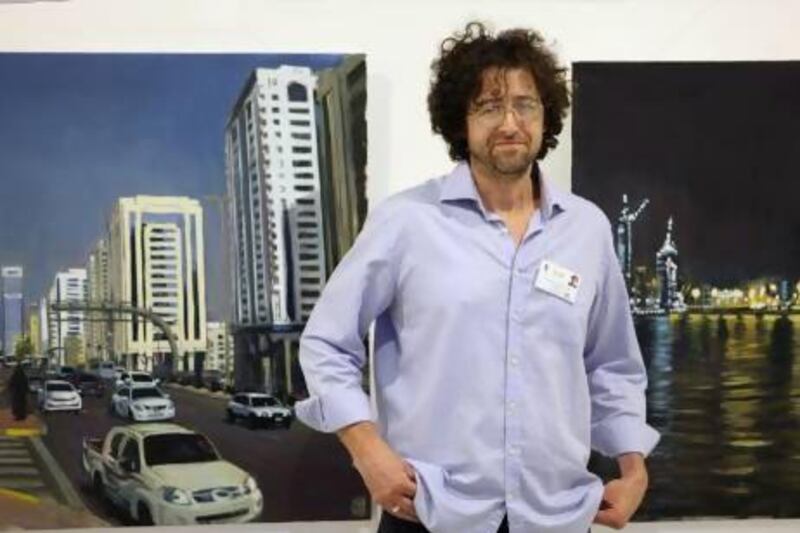ABU DHABI // When visitors are asked their impressions of Abu Dhabi, they might list the Sheikh Zayed Grand Mosque, Qasr Al Hosn, the Liwa Desert or Ferrari World.
Or they might describe Mussaffah.
A group of visiting Hungarian artists have found their muse in the industrial area on the outskirts of Abu Dhabi.
"Before travelling I thought that it will be surely very modern, and it was that," said Marton Takats, a landscape artist based in Budapest.
"I was also sure that it would be a little bit two-sided because there is the industrial, the dirty, and there is the very high-tech. So it's the two parts at the same time.
"It's the same thing in Hungary. One part is the city that is beautiful but there is another face that is also very interesting."
Takats is one of five Hungarian artists to exhibit at Art Hub Gallery last night after a month in the capital collecting inspiration.
"Art by Country" is an initiative by Ahmed Al Yafei to promote Abu Dhabi by inviting international artists to live in and experience the emirate.
Each month, artists from a different country come to live at Art Hub, the Mussaffah warehouse turned into a gallery, and explore a cross-section of Abu Dhabi life.
This includes visits to all the well-loved tourist spots, but for many artists the greatest treasures are in the grit and grime around The Malabar restaurant.
For the painter Luca Korodi, the greatest inspiration from her Abu Dhabi tour came from watching the gate man pray behind a metal container in a corner of the property.
"It was so intimate and these little things maybe tell me more than huge buildings," Korodi said.
"Of course, here is a richness but the big difference is between who is working and who is enjoying this.
"It's this big distance and I realised it's so much bigger than in my home but it's interesting.
"I am just looking at it, not saying it's good or bad."
Art by Country and the Art Hub were founded by Mr Al Yafei, an Adnoc chemical engineer turned property manager who hopes to develop Abu Dhabi's art community and identity before large galleries open in Saadiyat Island's Cultural District.
"We believe that fine art is the language of the world," Mr Al Yafei said. "Now having these artists from all over the world to absorb our culture and our landmarks and society, and represent it in artwork, will hopefully spread it all over the world.
"It is the best message about our identity and our culture, our previous and current social structures."
It will also help to develop a local sense of identity by examining Abu Dhabi's everyday with new eyes.
Abu Dhabi reminded the resident artist Abel Szabo of the quick-fire construction that he witnessed as a child in Romania.
Szabo loves the exposure of a city under construction.
"Abu Dhabi is very new, a very newly built city, and Budapest has a history through the ages," said Szabo. "And I'm interested to see how it's built, a very new city, of all new houses.
"Very interesting are the buildings where there's no grass, sometimes palms but without any grass. Just these buildings without surroundings."
The result of these visits is on the walls at Art Hub: paintings of the Formula One race, minaret skylines and Manga-style graffiti left by British, Arabian Gulf and Japanese artists who have visited since the programme's soft opening in October.
This month will be open to GCC nationals and next month it will be the Australians.
Mr Al Yafei hopes to attract about 50 artists a year, who will also host workshops during their residency.
"To some extent we give them total freedom, except the sensitive issues like nudity and religious things, direct politics," he said.
"We find that art is the common ground. We don't want to make art a part of the debate."
The Hungarian exhibition runs until March 13.
"I think that it's very closed, this world, because it is like a fairytale and a little bit surrealistic," said Katalin Verebic, a resident artist last month.
"Like my work sometimes - realistic and surrealistic mixed together."






